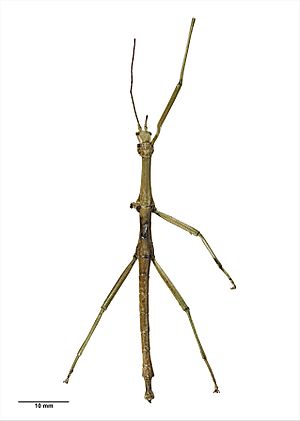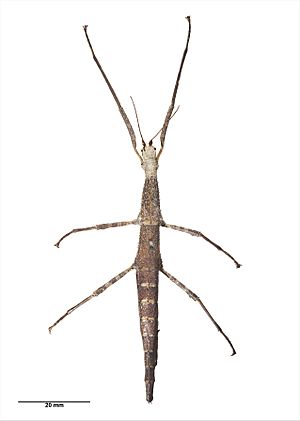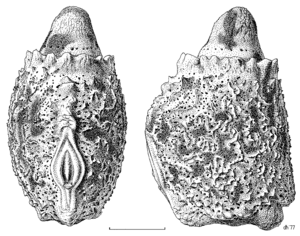Pseudoclitarchus facts for kids
Quick facts for kids Pseudoclitarchus sentus |
|
|---|---|
 |
|
| Pseudoclitarchus sentus (Salmon, 1948), male specimen held at Auckland Museum, licensed under CC BY 4.0 | |
 |
|
| Pseudoclitarchus sentus (Salmon, 1948), female specimen held at Auckland Museum, licensed under CC BY 4.0 | |
| Scientific classification | |
| Kingdom: | |
| Phylum: | |
| Class: | |
| Order: | |
| Suborder: | |
| Superfamily: | |
| Family: | |
| Genus: |
Pseudoclitarchus
Salmon, 1991
|
| Species: |
P. sentus
|
| Binomial name | |
| Pseudoclitarchus sentus (Salmon, 1948)
|
|
| Synonyms | |
|
|
Pseudoclitarchus sentus, also known as the Three Kings stick insect, is a fascinating creature found only on the Three Kings Islands in New Zealand. It is the only species in its group, the Pseudoclitarchus genus. This amazing insect spends most of its life blending in perfectly with the kanuka trees where it lives.
Contents
Meet the Three Kings Stick Insect
The Three Kings stick insect is a type of stick insect, which are insects famous for their incredible camouflage. They look just like twigs or leaves! Pseudoclitarchus sentus is a master of disguise, making it very hard to spot among the branches of the kanuka trees. These insects are part of a larger group called Phasmatodea, which includes all stick and leaf insects.
Where Do They Live?
This special stick insect lives only on the Manawatāwhi / Three Kings Islands. These islands are a small group located off the northern coast of New Zealand. Because Pseudoclitarchus sentus is found nowhere else in the world, it is called an endemic species. Its main home is the kanuka tree, a common native tree in New Zealand.
What Do They Look Like?
Like many stick insects, Pseudoclitarchus sentus has a long, slender body that helps it look like a twig. It can be different shades of brown or green, perfectly matching the bark and leaves of the kanuka trees. This camouflage helps it hide from predators like birds. Male and female stick insects can sometimes look a bit different, with males often being smaller or having slightly different body shapes.
What Do They Eat?
The Three Kings stick insect is a herbivore, meaning it eats plants. Its diet mainly consists of the leaves from the kanuka trees where it lives. They munch on these leaves, getting all the energy they need to grow and survive.
Life Cycle
Like all insects, Pseudoclitarchus sentus goes through different stages in its life.
- Egg: The life cycle begins with an egg. Stick insect eggs often look like tiny seeds, which helps them stay hidden from predators. The female insect lays these eggs, sometimes dropping them to the ground.
- Nymph: When an egg hatches, a tiny baby stick insect called a nymph emerges. These nymphs look like miniature versions of the adult stick insects. They grow by shedding their outer skin, a process called molting, several times.
- Adult: After several molts, the nymph becomes an adult. Adult stick insects are ready to reproduce and continue the life cycle.
Staying Safe: Camouflage
The most amazing thing about Pseudoclitarchus sentus is its ability to blend in. Its body shape, color, and even the way it moves help it look exactly like a part of the tree. When it feels threatened, it might stay perfectly still, swaying gently to mimic a twig in the wind. This incredible camouflage is its main way of staying safe from animals that might want to eat it.


